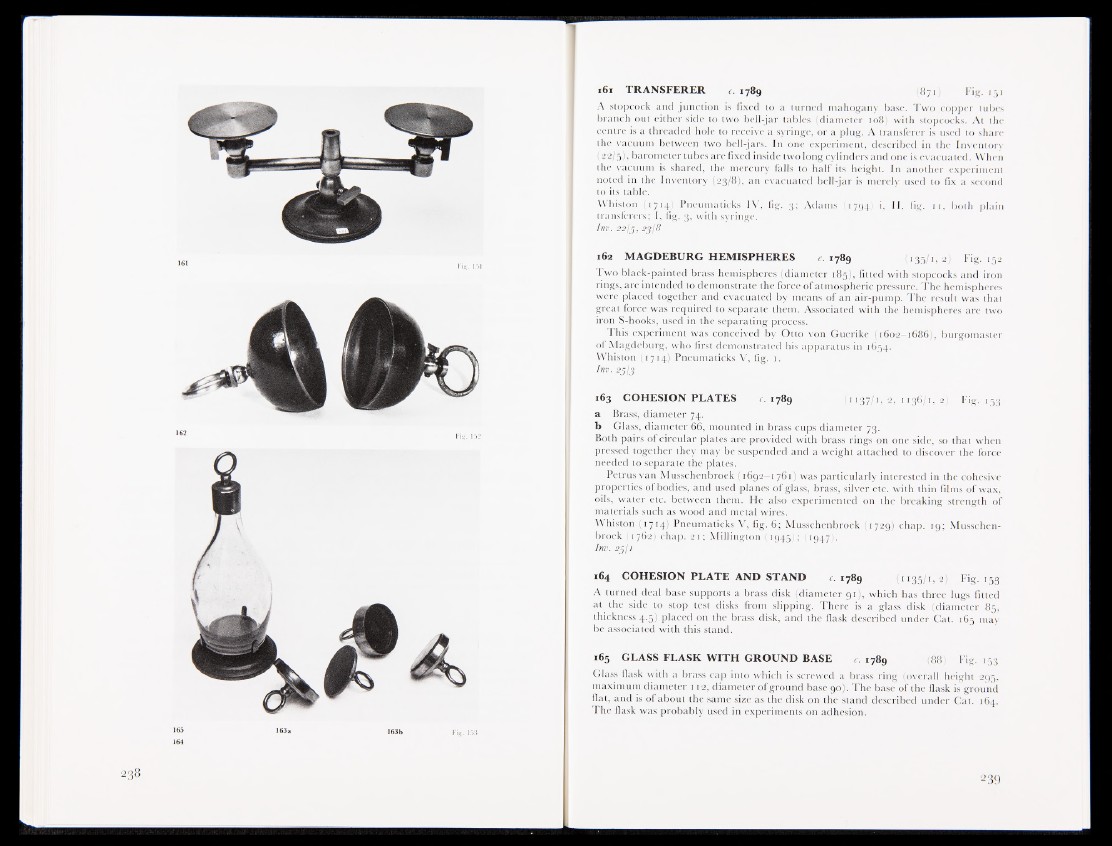
161 TRANSFERER c. 1789 (871) Fig. 151
A stopcock and junction is fixed to a turned mahogany base. Two copper tubes
branch out either side to two bell-jar tables (diameter 108) with stopcocks. At the
centre is a threaded hole to receive a syringe, or a plug. A transferer is used to share
the vacuum between two bell-jars. In one experiment, described in the Inventory
(22/5')> barometer tubes are fixed inside two long cylinders and one is evacuated. When
the vacuum is shared, the mercury falls to half its height. In another experiment
noted in the Inventory (23/8), an evacuated bell-jar is merely used to fix a second
to its table.
Whiston (1714) Pneumaticks IV, fig. 3; Adams (1794) i, II, fig. 11. both plain
transferers; I, fig. 3, with syringe.
Inv. 22/j, 2318
162 MAGDEBURG HEMISPHERES c.1789 (135/1,2) Fig. 152
Two black-painted brass hemispheres (diameter 185),, fitted with stopcocks and iron
rings, are intended to demonstrate the force of atmospheric pressure. The hemispheres
were placed together and evacuated by means of an air-pump. The result was that
great force was required to separate them. Associated with the hemispheres are two
iron S-hooks, used in the separating process.
This experiment was conceived by Otto von Guerike (1602-1686), burgomaster
of Magdeburg, who first demonstrated his apparatus in 1654.
Whiston (1714) Pneumaticks V, fig. 1.
Inv. 2513
163 COHESION PLATES c. 1789 (1137/1,2,1136/1,2) Fig. 153
a Brass, diameter 74.
b Glass, diameter 66, mounted in brass cups diameter 73.
Both pairs of circular plates are provided with brass rings on one side, so that when
pressed together they may be suspended and a weight attached to discover the force
needed to separate the plates.
Petrus van Musschenbroek (1692-1761) was particularly interested in the cohesive
properties of bodies, and used planes of glass, brass, silver etc. with thin films of wax,
oils, water etc. between them. He also experimented on the breaking strength of
materials such as wood and metal wires.
Whiston»i7i4) Pneumaticks V, fig. 6; Musschenbroek (1729) chap. 19; Musschenbroek
(1762) chap. 21; Millington (1945); (1947).'
Inv. 2511
164 COHESION PLATE AND STAND c. 1789 (1135/1, 2) Fig. 153
A turned deal base supports a brass disk (diameter 91), which has three lugs fitted
at the side to stop test disks from slipping. There is a glass disk (diameter 85,
thickness 4.5) placed on the brass disk, and the flask described under Cat. 165 may
be associated with this stand.
165 GLASS FLASK WITH GROUND BASE c. 1789 (88) Fig. 153
Glass flask with a brass cap into which is screwed a brass ring (overall height 295,
maximum diameter 112, diameter of ground base 90J. The base of the flask is ground
flat, and is of about the same size as the disk on the stand described under Cat. 164.
The flask was probably used in experiments on adhesion.